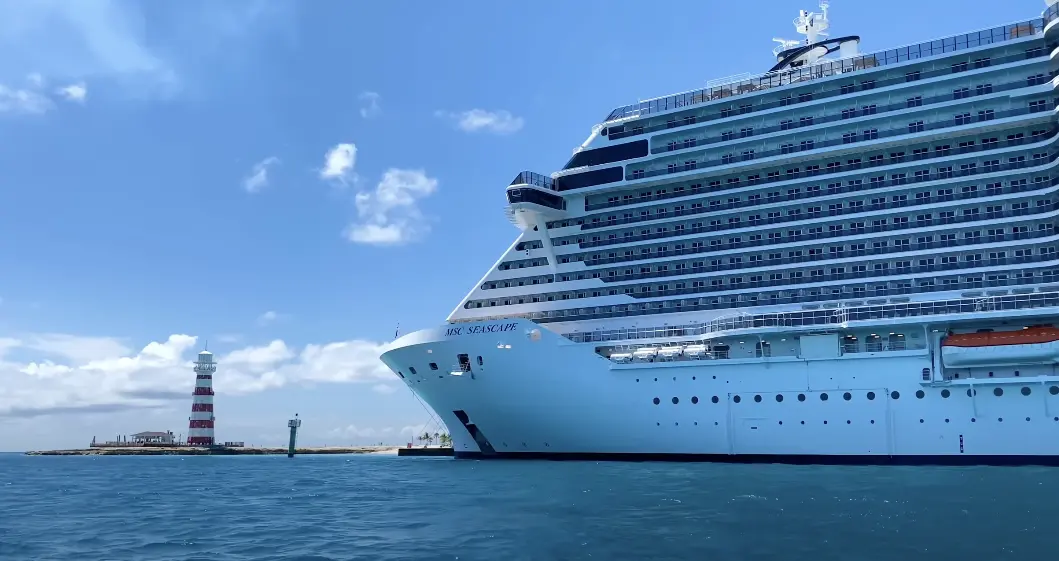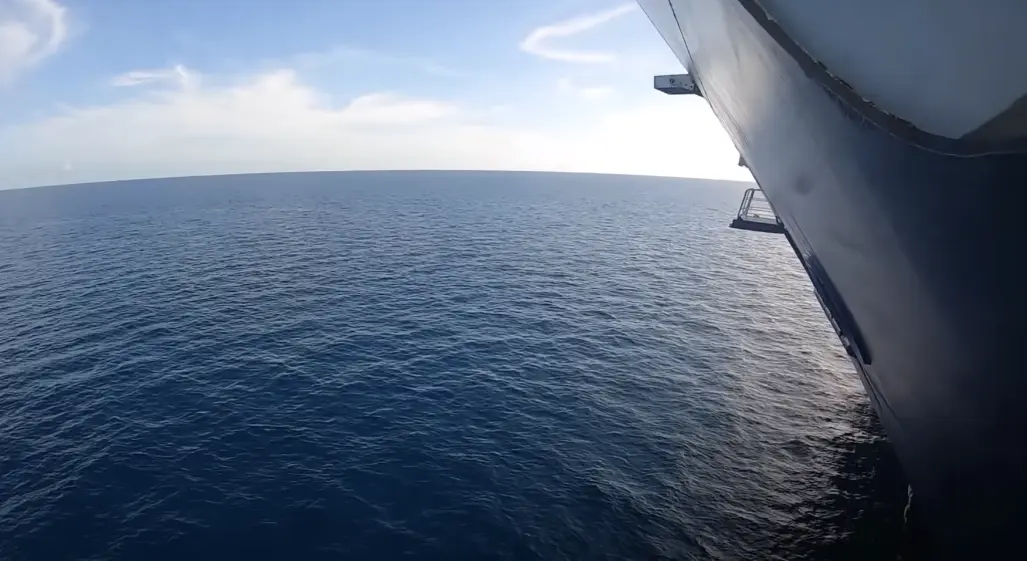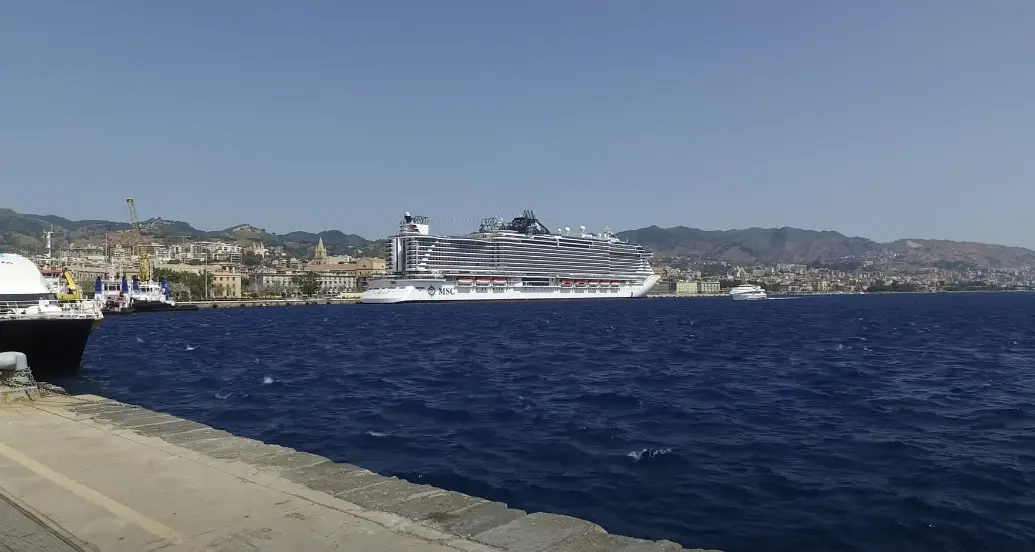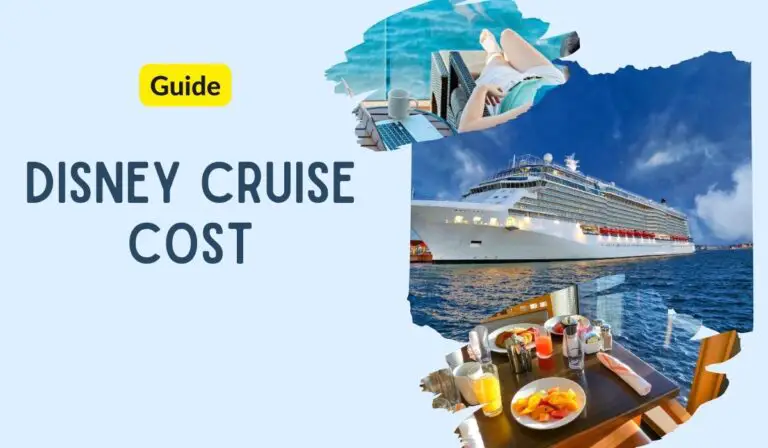How Much Of A Cruise Ship Is Under Water?
Many new cruisers often ask the question, “How much of a cruise ship is underwater, and why don’t they sink?” For me, it was a major curiosity until I got an answer. So, if you’re also one who wants to know the answer, you’re at the right place.
Basically, the ship’s depth under the water depends on the size of the ship and the amount of load being carried. Generally, around 10% of the ship’s height, or approximately 30 feet for the biggest cruise ships and 20 feet for the smaller ships, is underwater,
Sounds interesting, right? But wait, the science behind the ship floating is even more interesting, due to which they run seamlessly without being unstable.
So get ready, my fellow cruisers. I’ve discussed all the things in this article that will help you clear your doubts. The next time you cruise, you’ll be happy to see the facts with your own eyes. So let’s get started.
Cruise Ship Weight, Length, and Height Statistics

Before understanding the depth at which a cruise ship sits, it’s important to learn about the cruise ship’s weight, length, and height statistics.
The 50 largest cruise ships in the world, including those from Royal Caribbean and Carnival Cruise Line, weigh over 100,000 gross tons.
Regarding height, the average Royal Caribbean Cruise Ship measures 14 decks (stories) high.
In terms of length, these ships are approximately 20% longer than the Titanic, with an average length of 325 meters.
You can also check out my comprehensive comparison of modern ships and the Titanic.
How Does A Cruise Float?
Cruise ships float above the water line and don’t sink because of the following factors:
1- Hull Shape And Design

The ship’s hull and design are the major reasons why it doesn’t sink.
These U-shaped hulls push the water outward and downward, creating a buoyant force for the ship.
Not only that, but this massive hull also maximizes the water displacement, creating a lifting effect. A lot of modern cruise ships, including Royal Caribbean and Carnival Cruise Line, feature a V-shaped hull design to cut through the water efficiently.
Due to these hulls, the ship glides through the water with ease, maintaining stability and efficient floatation.
For physics lovers, let me explain with a principle. The hulls follow Archimedes’ principle, which states that the floating object is pushed up by a force equal to the weight of the liquid it displaces.
So yeah, now you must have a clear understanding of the science behind ship floatation and why it doesn’t sink.
How Deep Do Cruise Ships Sit In The Water?
Generally speaking, the answer varies due to the ship’s size.
Smaller cruise ships tend to sit lower in the water than the larger ones. It’s because they have less buoyancy and are more susceptible to being swamped by waves.
Both ship’s design and operation play an important role in the depth at which a cruise ship sits in the water.
Cruise ships typically sit between 12-15 feet below sea level when fully loaded with cargo, fuel, and passengers.
This depth helps the sea voyagers to stay stable while providing enough buoyancy for them to float.
However, it’s important to note that the depth of the cruise ship in the sea also depends on physical factors like rough seas and heavy load.
If the ship is sailing in rough seas, it may sit deeper in the water for increased stability. Likewise, for the heavy load, the depth of the ship will also be greater.

How To Measure The Depth At Which Ship Sit In The Water?
For measuring the depth at which a ship sits in the water, we look at the draft.
The draft size varies from ship to ship depending on the vessel’s size, fuel, and ballast.
Usually, cruise ships have a draft between 5 meters (16ft 5in) and 10 meters (32ft 10in).
The large cruise ships like Anthem of the Seas have a draft of 8.5 to 8.8 meters (about 28 feet). Likewise, the largest cruise ships, Royal Caribbean Oasis-class, have a draft of 9.3 meters (30ft 7in).
Smaller cruise ships typically have a draft of less than 7m (22ft 9in) so they can enter smaller ports.
Generally, the ship’s draft sizes are essential for determining the port the ship can enter.
I’ve mentioned the two terms that you’ll often hear when it comes to measuring the depth at which a ship sits in the water.
1- Draft Marks
Draft marks are the major indicator of how deep the ship is sitting in the water. These marks are located at the bow and stern.
With these marks, one can easily assess the ship’s draft, which is the depth from the waterline to the lowest point of the hull.
Next time, I suggest you focus on these marks to learn how much the cruise ship on which you’re traveling is submerged in the water.

2- Load Line
The second way I discovered this was on my last cruise ship on Royal Caribbean when I was sailing on Icon Of the Seas. It’s called the Plimsoll mark or load line.
This line is present at the center of a ship’s side, which indicates the maximum safe draft. It was named after Samuel Plimsoll.
In actuality, this line sets the limit to which the vessel can be loaded. There’s a line passing through the circle highlighting this maximum point, with a ladder arrangement showing different drafts for specific conditions.
The letters on the mark (T for Tropical, S for Summer, and W for Winter) denote maximum drafts under certain conditions.
Amazingly, the S load line is used to prevent overloading, as sailing with this mark submerged is illegal.
The N and V markings represent the ship’s classification society, ensuring adherence to international standards. This load line helps measure the ship’s depth in the water, ensuring compliance with safety regulations.
Why Do Cruise Ships Have Flat Bottoms?
Cruise ships work on the principle of buoyancy given by Archimedes’ Principle. So, for this reason, they have flat bottoms for increased stability and fuel efficiency.
Flat bottoms are highly beneficial in providing a larger surface area, thus increasing stability in calm as well as in moderately rough seas.
Not only that, flat bottoms allow for better weight distribution, preventing the ship from rolling excessively.
The Physics of Water Displacement
If you don’t enjoy physics like my husband, feel free to move on to the next section. But if you really want to understand the concept of a ship underwater, I suggest you have a look at this section.
As I already mentioned, the cruise ship’s underwater size is based on the Archimedes Principle, which explains the relation between the weight of an object and the fluid it displaces.
To make it simpler in cruise ship terms, this principle states that the ship must displace an amount of water equal to its weight to maintain stability.
The Role Of Ship Stability

Stability is a major concern while designing cruise ships. Several measures are taken to keep the ship stable, especially in the rough seas.
But do you know the science behind the ship’s stability? It’s all due to the low center of gravity and high buoyancy.
For a ship to be stable, its center of gravity must be low, and its buoyancy must be high.
As mentioned earlier, the large ship hull design helps the ship to be more stable by distributing the weight of the ship over the larger area and allowing for a more significant amount of water displacement.
With all these factors, a stable vessel is designed to provide an enjoyable experience to passengers even in the rough seas.
Read more about cruise stability here.
Explanation Of Cruise Ship Design Features
| Design Feature | Explanation |
| Wide Hull Design | A wide hull gives the ship more stability by displacing water over a larger area. |
| Low Center of Gravity | Keeping the ship’s center of gravity low helps maintain balance, especially in choppy waters. |
| High Center of Buoyancy | A high center of buoyancy ensures the ship stays afloat and avoids tipping over. |
| Stabilizers | Fins or gyroscopic systems reduce the ship’s rolling motion in rough seas for a smoother ride. |
| Ballast Tanks | These tanks adjust the ship’s weight and balance by filling or emptying as needed. |
How Much Water Does A Cruise Ship Hull Displace?
The amount of water displaced by a cruise ship’s hull follows Archimedes’ principle. According to this principle, the cruise ship displaces an amount of water equal to its own mass.
Let’s take an example of the largest cruise ship, Symphony of the Seas, which weighs approximately 228,000 tons and would displace 228,000 tons of water.
Now, you’ll have a clear understanding of how much water is displaced by the ship’s hull. Thanks to Archimedes’ Principle.
What Keeps a Cruise Ship From Tipping Over?
Cruise Ships are designed so efficiently that they are safe and stable.
A lot of people are curious to know why cruise ships don’t tip over, even if they’re so huge.
So, the combination of a wide hull, low center of gravity, fuel, and ballast tanks filled with water maintains a great balance and keeps a cruise ship from tipping over in rough seas.
What Extra Steps Are Taken For Extra Stability In Rough Seas?
The cruise ship’s stability totally depends on the center of gravity. It’s kept low to keep the ship stable, but it can be moved up or down by adjusting weights within the vessel.
The most obvious is ballast water and fuel. In extreme cases and rough seas, cruise ship swimming pools could be drained to provide additional stability as the weight of so much water on the upper decks will make the center of gravity higher.
Most cruise ships have a mechanical stabilizing system, and some have bilge keels, which also help to limit the amount of roll.
How Many Decks Are Underwater on a Cruise Ship?
The number of underwater decks on a voyage depends on its size and type.
However, cruise ships usually have one or two decks underwater, but passengers won’t find them as these decks are not named or numbered.
These are usually out of bounds for passengers as they contain various ship’s operational things and consist of hundreds of crew cabins to provide living and sleeping space for them.
So the next time you cruise, keep in mind that if you’re on Deck 1, you’re not the lowest on the ship. There are other decks under you.
The lower decks also need to house the following:
- Various engine and mechanical rooms
- Food storage units
- Laundry
- Medical Center
- Jail
- Morgue
- Crew-only social rooms
Do Cruise Ships Have Staterooms Underwater?
No, Cruise ships don’t offer underwater staterooms. However, there are cabins only for crew members to live and sleep in.
These are quite small and windowless as compared to those for cruise guests.
So, if you’re planning to book the underwater cabins, forget it, as they are only limited to the onboard crew members.
Why Don’t Cruise Ships Have Underwater Viewing Areas?
At the beginning of my cruise journey, I also asked my husband why the cruise line doesn’t offer underwater viewing areas to let us see all the marine life and coral reefs as we sail through the ocean.
But later on, I got an answer by myself. There are several reasons why cruise ships don’t have underwater viewing areas.
- Strength: Glass is not as strong as steel, which is crucial for handling sea pressures.
- Utilization: Underwater decks serve mechanical and crew needs, making structural changes challenging.
- Safety Concerns: Adding viewing areas may compromise ship safety during accidents or pressure.
- Cleaning Challenges: Windowed areas would require frequent cleaning due to algae buildup.
- Maintenance Costs: Regular cleaning and maintenance would be costly for cruise lines.
- Practicality: 99% of the time, an underwater viewing area would show disturbed water.
What Parts of a Cruise Ship Are Underwater?

Now, after knowing the ship’s floating science and the depth at which it’s underwater, you must be thinking about the vessel parts underwater.
These parts include:
- Bulbous Bow: The front part of the ships have a bulbous bow, a big projection that sticks out and changes how the water moves along the side of the ship.
- Propellers: At the stern, there are propellers designed to push through the water and move the ship forward or even backward in some cases.
- Hull: The U or V-shaped hulls displace large amounts of water, which increases the buoyancy force required to keep such large, heavy vessels floating.
How Much Water Does a Cruise Ship Need to Dock?
A cruise ship usually needs about 9 to 12 feet more than its draft to dock safely.
Let’s suppose that a ship has a 30-foot draft; it requires water depths of at least 40 feet for safe sailing, accounting for its bouncing movement.
FAQs
Where’s the Most Of the Cruise Ship Weight?
The majority of the ship’s weight is underwater to maintain the ship’s low center of gravity for extra stability in rough seas.
What’s On The Lowest Deck?
The lowest deck of the vessel, also known as orlop, it’s just below the cove balconies and contains essential components necessary for the ship’s operation including engine room. Also, it contains crew-only cabins for their living and sleep.
Final Words
Hopefully, now you have an answer to the question of how the cruise ship floats and its depth under the water.
Next time, you’ll enjoy your cruise even more after seeing all the above facts and science with your eyes.
Have a safe and enjoyable cruise.
I am Zoe Grace, a passionate enthusiast of cruise ships. With a decade of firsthand experience in the cruising industry, I have developed a deep understanding of the intricacies and wonders that these majestic vessels hold.
Now, I am excited to embark on a new journey as an author, sharing my knowledge and insights with readers who share my fascination for the world of cruising.
Join me as we explore the captivating world of cruise ships together.


![How Long Is A Cruise To The Bahamas? [Expected Time]](https://cruiseshipmania.com/wp-content/uploads/2023/09/Carnival-Cruise-Menu-6-768x448.jpg)

